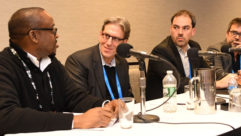An F.O.C. Primer
Jul 1, 2002 12:00 PM,
Irwin Math
In designing a fiber optic transmission system, the main task is to determine the specific optical transmitter and receiver combination most compatible with the signals to be transmitted. You must review equipment data sheets and consult with the sales engineers of the various manufacturers.
This first step can be fairly straightforward; however, once the equipment is chosen, the next consideration is the choice of the fiber optic cable itself, as well as the optical connectors to be used and the method of attaching them. This part of system design is not as clear cut and is clouded in misunderstanding. So it helps to look closely at the cabling portion of fiber-optic system design.
CABLE CONSTRUCTION
like copper wire, fiber optic cable is available in many varieties. There are single and multiple conductor constructions, aerial and direct burial styles, plenum and riser cables and even ultrarugged military-type tactical cables that will withstand severe mechanical abuse. The decision about the kind to use will depend on the installation, so it is important to know a little about the internal structure of the cable.
All fiber optic cable contains one or more hair-thin optical conductors or fibers. The delicate fibers must be properly protected from the outside world (especially if the cable they are contained in is to be installed and handled by the same contractors who install conventional copper cable). The two most common protection schemes in use today are enclosing the fiber in a loose-fitting tube and coating the fiber with a strong, tight-fitting buffer layer.
- Loose-Tube Buffer. In the loose-tube method, the fiber is enclosed in a plastic buffer tube whose inner diameter is larger than the outer diameter of the fiber itself so that there is no strain on the fiber. The tube is sometimes filled with a silicone gel to prevent the buildup of moisture. Because the fiber is basically free to “float” within the tube, mechanical forces acting on the outside of the cable do not normally reach the fiber. This type of cable can tolerate axial forces such as being pulled through conduit or being subjected to constant mechanical stress, as in aerial use. Furthermore, because the fiber itself is not under any significant strain, loose-tube buffer cables exhibit low optical attenuation losses.
- Tight-Coating Buffer. In the tight buffer construction, a thick coating of a plastic material is applied directly to the outside of the fiber. This method gives the cable a smaller overall diameter then loose-tube cable. Tight-buffer cable is also more resistant to crushing and impact; however, because the fiber is not free to float, the tensile strength of the cable is not as great. Tight buffer cable is normally lighter and more flexible than loose-tube cable and is therefore usually employed for less severe applications, such as within a building or between two pieces of equipment.You’ll note from cross sections of single, two-conductor and multiconductor fiber optic cable that the two-conductor cable is similar in construction to common “zip cord” electrical AC power line cable. In all cases the fiber/buffer tube is first enclosed in a layer of synthetic yarn, such as Kevlar, for strength. Then an outer jacket of PVC or similar material is extruded over everything to protect the inside of the cable from the rigors of the operating environment. In multifiber cables, an additional strength member is sometimes added. Although most fiber optic cables are manufactured of nonconductive materials, some cables use steel-tape-wound outer jackets for rodent resistance (direct burial types) or metallic strength members such as steel wire for aerial (telephone pole) use. Some fiber optic cables are imbedded with copper electrical conductors for transferring power to remote electronic packages.
- The Optical Fiber. Whether buffered in a loose tube or a tight coating, the actual glass fiber used in fiber optic cable comes in one of two basic categories: multimode or single mode. Multimode fiber is used over short to moderate transmission distances (up to about 10 km), and single-mode fiber is used over distances that are generally greater than 10 km. Communications-grade multimode fiber normally comes in two sizes, referred to as “50/125” or “62.5/125,” in which the first number represents the light-carrying core of the fiber. The second represents the outer-fiber diameter. The most common type is the latter, but both have the same outer diameter and can usually use the same optical connectors. Single-mode fiber comes in only one size: 8-10 microns for the core and 125 microns for the outer diameter. Due to the smaller core, optical connectors for single-mode fiber are not the same as those designed for multimode fiber, but they can look the same to the untrained eye.There are two methods of light propagation through an optical fiber. Step-index fiber is manufactured with a core of ultrapure glass surrounded by a cladding layer of standard glass with a higher refractive index. That causes light traveling within the fiber to continually bounce between the walls of the core, much like a ball bouncing through a pipe. Graded-index fiber is made entirely of ultrapure glass that has been treated so that it behaves like a long lens, continually refracting the light toward the center of the fiber. Although a graded index fiber has no real core, an effective core represents that portion of the fiber that carries most of the light. Regardless of the fiber type, the light is effectively trapped and does not normally exit (except at the far end).
- Signal Loss. Losses in an optical fiber are the result of absorption, impurities within the glass and mechanical strains that bend the fiber so sharply that light is actually able to leak out through the cladding region. Losses are also dependent on the wavelength of the light used, because the amount of light absorbed by any type of glass varies for different wavelengths. For example, a wavelength of 850 nanometers (the most commonly used in short-range transmission systems) has a loss of 4 to 5 dB per kilometer. At 1310 nm, loss drops to less than 3 dB per km, and at 1550 nm, the loss is about 1 dB. The latter two wavelengths are therefore used for longer transmission distances.
Absorption and mechanical loss is independent of the frequency or data rate of the signals being transmitted. Another loss factor, however, is dependent on frequency and wavelength, because light can take many paths through a fiber since an optical emitter produces a beam of light that is usually larger in diameter than the fiber. A straight light path is shorter than a light path with a lot of bouncing. That means that for a fast rise-time pulse of light at the fiber input, some light will reach the output sooner, and some later. This causes a smearing or spreading effect on the output rise-time of the light pulse and effectively limits the maximum speed of light changes that the fiber will allow.
Because data is usually transmitted in pulses of light, this multipath effect limits the maximum data rate of the fiber. The spreading effect for a fiber is expressed in terms of MHz per kilometer. Standard 62.5/125 multimode fiber usually has a bandwidth limitation of 160 MHz per km at 850 nm and 500 MHz per km at 1310 nm due to its large core size compared with the wavelength of the propagated light. That means that a 1 km fiber optic transmission system operating at 850 nm will only be able to pass a 160 MHz signal. Increase the distance to 2 km and the bandwidth decreases to 80 MHz. Change the operating wavelength to 1310 nm and the bandwidth jumps to 500 MHz for the 1 km link and 250 MHz for the 2 km link.
Most long-distance transmission systems use single-mode fiber because of its small, 8-10 micron core diameter, which has a bandwidth of thousands of MHz per km (at a wavelength of 1310 nm). For most low-frequency applications, however, the loss of light from absorption will limit the transmission distance more than the pulse spreading effect.
OPTICAL CONNECTORS
because the tiny core of an optical fiber is what transmits the actual light, it is imperative that the fiber be properly aligned with optical emitters in transmitters, photo-detectors in receivers and adjacent fibers in splices. Ensuring that alignment is the function of the optical connector, a precision device with tolerances on the order of microns. Although there are many styles, the most common optical cable connector is the ST type. This connector has a center pin that houses the actual fiber, a spring-loaded mechanism that presses the pin against a similar pin in a mating connector or electro-optic device, and some method of securing and strain-relieving the outer jacket of the fiber optic cable. ST connectors are available for both multimode and single-mode fibers. The main difference between the two is the precision of the central pin. Because the difference is not readily noticeable by the unaided eye, care must be taken to use the correct connector. Although single-mode connectors will work properly with multimode emitters and detectors, the reverse is seldom true.
- Termination. The traditional method for attaching, or terminating, optical connectors to a fiber optic cable consists of first stripping the jacket from the fiber cable with tools that are almost exact equivalents of those used for electrical cable. Once that is done the strength members are trimmed and inserted into various restraining grommets or sleeves. For loose-tube fibers, the buffer tube is removed, exposing the fiber. For tight-buffer fibers, the buffer coating is removed with a precision stripping tool that looks like a small wire stripper.
The process up to this point is similar to preparing copper wire, but when the bare fiber is exposed the similarities end. The stripped fiber is coated with a quick-drying epoxy resin and inserted in to a precision hole or groove in the connector pin with the front of the fiber protruding somewhat from the connector pin. Then the strain relieving components are assembled, and the epoxy is allowed to cure. Now the basic connector is ready for finishing.
At this point the pin is placed in a special tool used to cleave or cut the tiny glass fiber flush with the end of the pin, which takes only a few seconds. Next the connector is placed into a small jig and slid over two or three grades of lapping film (the equivalent of ultrafine sandpaper). That effectively polishes the fiber and gets the optical connector ready for use. The complete task, not including the five minutes of epoxy drying time, takes anywhere from one to five minutes per connector depending on the skill level of the technician.
Many inexperienced installers have reservations about connecting fiber optic cable due to what they have heard about the grinding and polishing of glass. When one realizes that the grinding and polishing takes less than a minute and is done within a simple foolproof fixture, the mystery quickly disappears. In fact, assembling an ST-style optical connector is really no more demanding a task than assembling an older-style electrical BNC. Nevertheless, reservations persist. As a result, several connector manufacturers make “quick-crimp” optical connectors. These devices are installed with various mechanical clamp arrangements, hot melt or instant bond adhesives or, in some cases, no chemical adhesive at all. Some of the connectors even come with a prepolished length of optical fiber already installed in the tip, thereby eliminating the finishing step. Although these are a bit easier to install, the “epoxy-polish” method is really not one that anyone should fear. The figure above shows the steps in installing conventional ST connectors.
Other optical connectors, such as the SMA, SC and FCPC, are similar in principle in that they position the fiber in a close tolerance pin which then mates with an equally precise device on the other end. They really only differ from each other in the mechanical way that connectors mate to each other. In any event, all optical connector manufacturers provide detailed, easy to follow step-by-step installation procedures for their connectors.
There’s no black magic in using fiber optic cable, and the technology is really unsurpassed wherever interference-free, high-quality signals have to be transmitted from one point to another.
Irwin Math was the founder of Math Associates Inc., one of the pioneering firms in fiber optic technology. His new company, Liteway Inc., carries on the tradition of manufacturing cost-effective, self-contained fiber optic links. He may be reached through liteway.com.
TERMINATING WITH EXTREME PREJUDICE
Adding an ST connector to a fiber optic cable need not strike fear into the heart of the technician:
- Slide boot and crimp tube over end of fiber
- Strip fiber optic cable to dimensions shown
- Cleave, and apply epoxy
- Assemble and crimp
- Complete connector.










